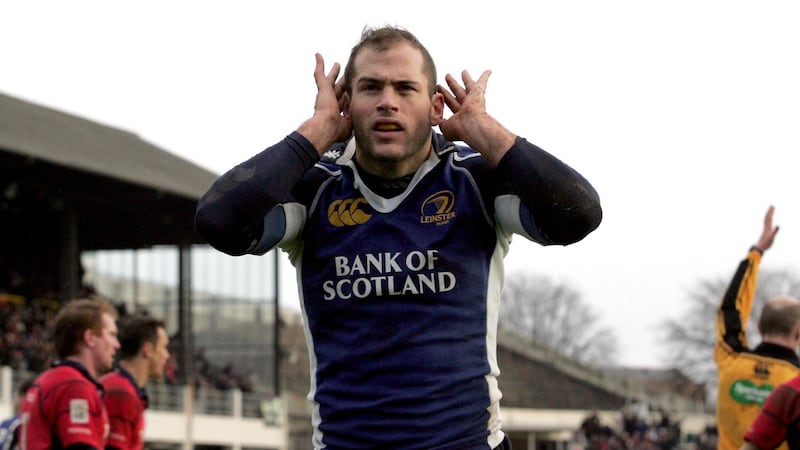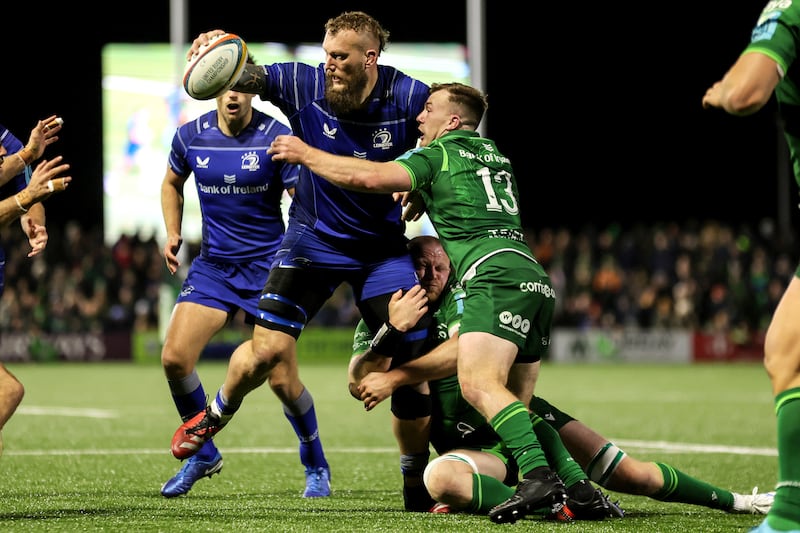One of the memories I have of Felipe Contepomi was in 2002 when a young 24-year-old dotted the ball down to fire Bristol to their first final of the professional era.
Felipe’s celebration was perhaps more widely remembered than the try itself.
The gifted playmaker, perhaps the first of the genuine attacking outhalves, glided through the Northampton defence almost untouched to touch the ball down. It didn’t stop there as he continued running into the stand, sat down and began to applaud his own try with the local support.
It was a pleasure to play alongside Felipe, and I always loved the joy and passion with which he approached the game. He competed with a smile on his face, the spirit of rugby was in his DNA and he wanted to attack whenever possible. He celebrated tries freely, with some more personal than others. He particularly relished when he scored a try or two against Munster.
Not unlike Felipe, RG Snyman is clearly enjoying his current run of early games with Leinster, scoring tries with a broad smile across his face. It’s a good reminder to everyone that, at its core, sport is pure and needs to be enjoyed.
The exceptionally large South African lock has also shown many times this season that his vision and skill set can override pure physicality when needed.
There are moments when rugby relies solely on physical attributes and a narrow focus, such as when sprinting for a loose ball or counter-rucking. Then there are other opportunities to be more thoughtful about. Taking the time to spot defenders in the wrong position or even a simple misalignment by the defence.

Finding that balance is very liberating as a player.
Antoine Dupont and Snyman were both heavily involved in the creation and scoring of tries over the weekend. Dupont produced a no-look reverse pass try assist for Toulouse against Pau, and Snyman gathered a bobbling ball to pirouette around Connacht defenders, who were chasing the ball.
The two tries were very different in their making, but they had similar characteristics.
The Toulouse scrumhalf, as he was tracking the peel around the front of the lineout, was also constantly scanning the opposition and his own team.

Who will be named in Ireland’s November squad?
He knew exactly where everyone was, and because he had taken the time to slow down mentally, the opportunity arose. Of course, why not add a bit of trademark flair. The same could be said of Snyman.
In one move involving Garry Ringrose carrying over the gainline, there were three ensuing rucks that the World Cup winner could have chased. Instead, taking regular quick glances, he saw the rucks were adequately resourced. He was then able to track the play, and be in the right place at the right time for the bounce of the ball. With nine offloads, Snyman created more than the rest of his team, who offloaded eight times combined.
Watching the way that RG entered tackles before offloading is interesting as well, as he already sees the pass he wants to make before taking contact. I only had a couple of successful offloads in my career and those attempts were instinctive, like a reverse flick to Brian O’Driscoll against England in 2009 for a Girvan Dempsey try.

Once I started to try and think about them, they became a self-fulfilling mess, where I was focused on the release of the ball, or the offload, and then other parts of the process would fall away, ending with the ball, or my ass, on the ground. It wasn’t a natural skill for me, and I was trying to develop it perhaps too late in my career.
I believe having natural offloading players in your team is a hugely valuable commodity in rugby today. I was watching a clip of Dan Carter making his return to club rugby for the Canterbury team Southbridge RFC in 2020, and there were a couple of clips where he turned a 2v2 scenario into a line break by virtue of an offload.
By simply spotting the opportunity and engaging the second defender with a strong carry, it opened up the offload. Carter released the offload and accepted the trade-off hit from the second defender, creating the line break.
There is an argument that a pass might do, but an offload when successful is so much harder to defend. I have felt that this was always a point of difference for the All Blacks in my era, where any number of players were able to create a different point of attack with an offload, which the Irish players weren’t able to cope with.
In general, I still feel there is a lot of structure in the way most teams set up and have a reliance on a few key players to change things up. However, once an offload is thrown in, it immediately changes the shape of the attack, forces players to think on their feet and the defence is usually just a tiny bit slower to respond.
Snyman, even after a couple of games, has become critically important to the way Leinster play the game. He brings an immediate sense of unpredictability that will complement the skills of players such as James Lowe, Jamison Gibson-Park, Jamie Osborne and Ciarán Frawley.
Hopefully, like Felipe did when he played with Leinster, RG will leave a lasting legacy for others by unlocking a little more creativity in the younger generation.
- Listen and subscribe to our Counter Ruck rugby podcast
- Sign up for push alerts and have the best news, analysis and comment delivered directly to your phone
- Find The Irish Times on WhatsApp and stay up to date

















